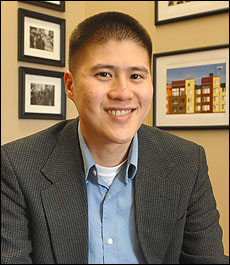Archives
Bridging the divide on immigration
Su says legal scholarship on the topic often ignores impact of local regulations
By KEVIN FRYLING
Reporter Staff Writer
The son of Taiwanese immigrants, Rick Su says he felt an almost unconscious attraction to immigration law after entering Harvard Law School in 2001.

Rick Su’s scholarship involves the
intersection of local and national laws concerning
immigration.
PHOTO: NANCY J. PARISI
Being raised in the United States, as well as officially earning U.S. citizenship only a few years ago—although he came to the U.S. at age 6—give him a unique perspective on the topic, he says, one from which both sides of the issue are visible.
“I’m saddened by how intense and by how dehumanizing this debate has become,” says Su, who joined the UB faculty last fall as an associate professor in the Law School, “but at the same time, I recognize the rationale behind the intensity of the emotions.”
Whether it’s immigration opponents turning people into statistics or immigration proponents portraying critics as racists, Su says there’s little to gain from an approach that relies on charged rhetoric and emotional accusations.
“You don’t get anywhere by sitting around in shouting matches,” he says. “I think there’s lots and lots of middle ground, and that the debates get too narrow and tunnel-visioned.”
Su’s specific research interest involves the intersection of local and national laws concerning immigration. He explains that most current immigration scholarship focuses on national borders and ignores the vast impact local regulations can have on foreign populations—even after they’re granted legal access to the country. When immigrants enter the United States, he says, they are not thrown into a “frictionless society.”
“One of the things that fascinate me about immigration law and local government law is that the two disciplines just don’t talk to each other,” he says. “There’s this idea in immigration literature—because it focuses purely on national borders and citizenship—that national migration is unrestricted other than at national borders; that the national border organizes population flow. But from a local government perspective, that’s not the way society is set up. Traversing any neighborhood, any region, you know where you’re ‘supposed to go’ and where you’re not. People in certain immigrant communities, in a very real sense, feel trapped.”
Part of the situation is socioeconomic, he adds, while also noting that local zoning regulations that limit the development of multifamily and other affordable housing, and housing codes concerning the number of nonfamily or extended-family members permitted in a single household frequently are enforced in ways that target immigrants trying to overcome the financial barriers in certain communities.
“It’s not a mystery why these things are being applied,” Su says. “It’s not like the old days of racial zoning where there were clear barriers to entry, but it does operate.”
Other more subtle tactics that restrict immigrants from certain communities include municipal laws that limit translation services and prohibitions on signage in foreign languages, he adds.
“We not only use regulation at the borders, but regulation in local communities to temper and fine-tune the various conflicting interests of our immigration regime,” Su says. “The argument I’m raising is that both are imperfect—national borders are imperfect, local borders are imperfect—but both are at play.”
The recipient of a bachelor’s degree in English from Dartmouth College and a law degree from Harvard, Su says his interest in local law stems from his experience as co-author of “Dispelling the Myth of Home Rule,” published in 2004 by the Rappaport Institute for Greater Boston, in which he and two faculty mentors from Harvard investigated the role of local governance in regional decision-making. After serving a prestigious clerkship for Judge Stephen Reinhardt of California’s Ninth Circuit Court of Appeals from 2004-05, Su returned to Harvard as the 2005-06 Charles Hamilton Houston Fellow for Law Teaching. He joined the UB faculty after a clerkship in the Legal Honors Program at the U.S. Department of Housing and Urban Development.
“The University at Buffalo was one of the few places where it felt like people were genuinely interested in the scholarship side of law,” Su says. “The fact that the law school is in the middle of campus—it’s interconnected to all the other components—made me feel that this is a place where the law school is considered a critical component of the academic agenda, not just a money-maker left on the side.”
Su currently is teaching an upper-level course on “Local Government and Law,” as well as working on articles related to immigration for several law journals, including the North Carolina Law Review. He also presented a lecture, “The Fragmented Model of Immigration Law: Localism as Second Order Immigration Regulation,” as part of the 2007-08 Baldy Center Seminar Series, “The Immigration Crucible.”
“I’ve been fortunate to have good, motivated students,” says Su, who last fall also taught a course on immigration. “I use a modified Socratic Method—it’s very much participatory and discussion-based—and they’ve been very willing to play with ideas and very willing to step out of a world where there are clear answers and realize the complexities of different situations.”
Su lives in the Parkside neighborhood of Buffalo with his wife, Jessica Houston Su, who works from home as a research associate at the John F. Kennedy School of Government at Harvard.
“Buffalo’s a beautiful city,” Su says, pointing not only the architecture, but also the vibrant neighborhoods in the city. “Certain streets just have that feel to them. I feel like the other cities I’ve lived in have these sorts of areas, but in terms of the sense of community, it just didn’t exist.”
